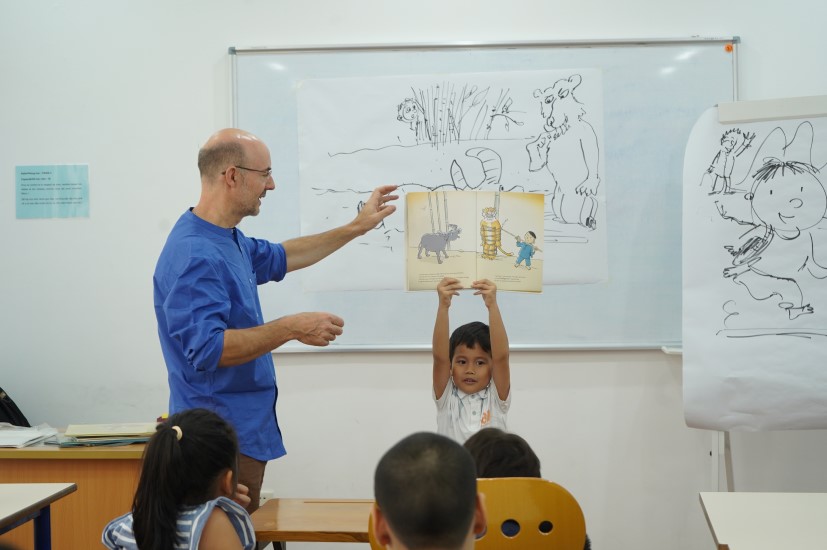In 1987-1988, French cartoonist Jean-Charles Sarrazin explored the streets of Hanoi and the countryside, capturing around 300 photographs that focused mainly on the life of Hanoi residents, street corners, houses, and rural scenes. Additionally, he sketched numerous scenes in Hanoi, Vietnam, which he has preserved to this day. These works have been exhibited in several small exhibitions in Paris.
Sarrazin returned to Hanoi to share his inspiration with the people and use it as material for his artworks.
Even after nearly 40 years since his first visit, Sarrazin’s love for Vietnam remains unchanged, and he is always ready to return to Vietnam to find creative inspiration and exchange ideas with readers and colleagues.
A talented fine arts student from Hanoi
In 1986, as a soon-to-be graduate of the Olivier de Serres University of Industrial Fine Arts, Sarrazin had the chance to meet poet Cu Huy Can, who was the Minister of Culture on a business trip to Paris.
During their meeting, Sarrazin expressed his desire to study abroad, and in response, the minister posed a question: “Why not come to Vietnam?”
Thus, it was poet Huy Can who connected the young Frenchman with art schools in Vietnam.
Sarrazin developed a project to share his artistic knowledge, which he submitted to the Hanoi University of Industrial Fine Arts. The French student also displayed an interest in learning traditional Vietnamese skills such as lacquer painting, wood carving, silk painting, and more, and even offered to teach at the School of Traditional European Arts.
“The project convinced the leaders of the University of Industrial Fine Arts, and they accepted it.” Sarrazin recalled. “At that time, the French Ministry of Foreign Affairs decided to create a scholarship for this initiative, which they awarded to me. This was the first scholarship awarded to a French student for studying in Vietnam since the war.”
Although Sarrazin’s studies in Vietnam lasted only one year, he had the opportunity to meet several renowned artists such as Bui Xuan Phai, Buu Chi, as well as art teachers like Trinh Tuan (Hanoi University of Industrial Fine Arts) and Tran Trong Vu (Vietnam University of Fine Arts).
“We would ride our bikes through the countryside, visiting temples and traditional festivals, while painting and taking pictures,” shared the French artist.
For Sarrazin, Mai Chau (Hoa Binh) left the strongest impression due to its serene landscape, authentic cuisine, and the stilt houses of the Muong ethnic people. During a bicycle trip, the French artist also visited Tay Phuong Pagoda and Thay Pagoda in Hanoi, where he was captivated by the intricate artistic motifs.
Since then, he has made multiple trips to Vietnam to showcase his works through lectures, workshops, exhibitions, and discussions with readers.
Cultural connections with Vietnam
To this day, Jean-Charles Sarrazin holds fast to the traditional method of creating books, rejecting the technology available to graphic designers. He firmly believes that “children with innocent souls will easily understand what is closer, purer, and dearer.”
Sarrazin admitted that his time studying and researching in Vietnam had a profound impact on his life. “During my time in Vietnam, I was exposed to a culture that was different from mine. As I studied Eastern culture, I witnessed the interplay between the East and the West,” shared the artist, who drew inspiration from Vietnamese art after meeting several prominent Vietnamese painters.
His creations are influenced by Vietnamese art and culture, including wood carving, lacquer painting, silk painting, and other skills he acquired during his time in the country.
In particular, he published a book inspired by the fairy tale “Here is My Wisdom.”
Sarrazin’s book tells the story of a buffalo and a tiger, but the man who owned the buffalo is replaced by a boy to make the story more child-friendly.
Through the dialogue in the story, the artist aims to convey the message that everyone possesses their own intelligence and must know how to use it properly. This is also the goal of his creations: to help children develop their personalities from an early age.
“I am delighted that this book is loved by Vietnamese children, especially when I saw how students adapted it into a play,” he said.
This year, at the invitation of the French Institute in Vietnam, Sarrazin will hold exhibitions, exchanges, and workshops in Hanoi, Hue, Danang, and Ho Chi Minh City to share his work and creative process.
“For me, Vietnam is a cherished and beloved country. My journey with Vietnam continues. Thank you, Vietnam, for all the wonderful experiences you have given me,” Sarrazin concluded.









